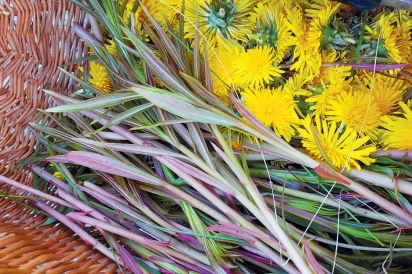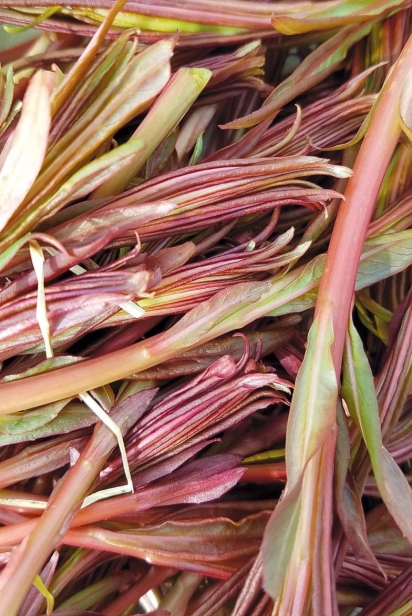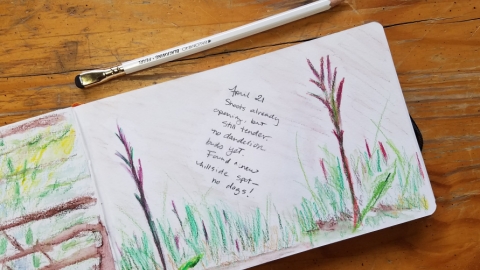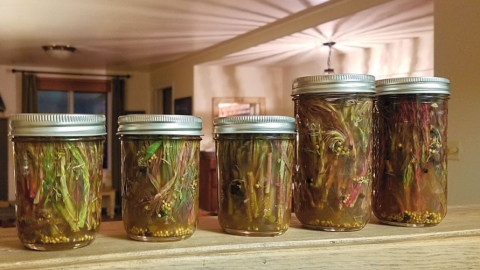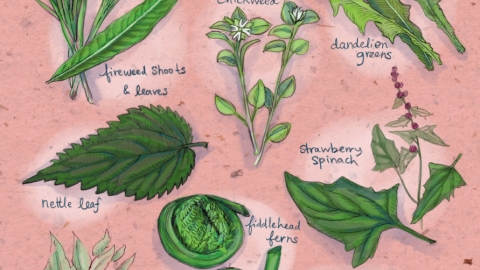Finding Fireweed - The Phoenix of Foraging
Do you think of fireweed as a spring edible? Picking fireweed blossoms and making syrup from their flowers happens to be one of the first foraging and wild food experiences I had after arriving in Alaska. It was a few years before I learned that the entire plant is edible and that, in fact, the fireweed shoots that appear in spring are my favorite part — they’re ready to eat long before their flowers bloom
Named because of its pyrophytic, or fire-adaptive, properties, fireweed is often the first plant to emerge from the ashes of a forest fire. Common even in the rainforest regions of Alaska, in mid -to late summer its allure is irresistible. Near Juneau, vast fields blossom into purple carpets leading to glaciers. Elsewhere, it blends with yarrow and lupine, lighting roadsides afire with color. This resilient beauty has a huge range throughout the northern hemisphere, but it is still identified as distinctly Alaskan. We love and fear the beauty of the blooms because, in spite of their showy appearance, they are a harbinger of winter.
Yup. When the fireweed is done blooming, many consider summer officially over.
Start looking for fireweed shoots after snow melt, probably in early April. Like so many so-called weeds, fireweed loves disturbed ground. I find it also likes wet, even boggy sites, and often shares habitat with other grasses and dandelion. The new shoots are dark red and you have to get your “fireweed goggles” on, paying close attention until your eyes adjust to their natural camouflage that includes leaf rot and twigs. Soon, you’ll be spotting them easily. Reach down and snap shoots off just above or just below ground level — some people really love to eat the white part of the stalk that lies just below ground. Don’t pull the roots out. Fireweed grows on underground runners and pruning will encourage growth but, nonetheless, don’t overharvest. I like to follow a 10% rule, taking no more than that in the general area where I’m foraging. (With more sensitive species, this rule changes to 1% or less). Remember, any shoot you take won’t flower later in the season.
Fireweed, (botanical name epilobium angustifolium) is in the evening primrose family. Author and wild plants expert Janice Schofield writes that there are up to 20 varieties of epilobium in Alaska. You might also see epilobium latifolium, called “river beauty” or “dwarf fireweed.” It has very similar blossoms, but is short and squat, close to the ground, and just as delicious. With many common edibles, if it seems like you missed your window in a particular season, you can go up in elevation and go back in time a little bit, possibly finding what you were looking for.
Herbalist Elise Krohn prizes fireweed for its soothing qualities. She writes that it’s often used as an anti-inflammatory and to support digestion. The fresh shoots have good quantities of vitamins A and C. Since it often appears right after a natural disaster, it makes sense that the folks at The Alaska Flower Essence Project (an organization dedicated to understanding and sharing Alaska flower essences) find the resilience of this flower to be healing. According to their website, fireweed “heals shock and trauma; strengthens our grounding connection to the Earth; helps us break up and move out old energy patterns that are being held in the body and initiate new cycles of revitalization and renewal.”
That’s quite a weed.
You can eat firewood shoots raw out of the ground — in fact, if you’re wondering if they’ve gotten too big to eat, just take a bite. If they’re tender and easy to chew, they’re still a great addition to your next meal. If they’ve gotten woody and tough, then find some smaller plants. Generally, if the leaves are still close to the stalk, and there’s some red tinge to the plant, you’ve found a usable shoot.
New fireweed shoots have a visual resemblance to asparagus and, with their mild tannic flavor, a subtle similarity in taste. This leads me to prepare fireweed like I would young spring asparagus. If you can’t eat your shoots right away, you can freeze them, but they’re so tender that I recommend using the frozen shoots within a couple of weeks. To clean the just harvested shoots, submerge in cold water to let dirt and debris fall off, then rinse in a colander. Dry gently.
Sautéed Fireweed Shoots
Fireweed shoots can be chopped and used in salad even without blanching, but the shoots also take heat well. Try a quick, hot sauté in olive oil, sprinkle with sea salt, and drizzle on just a little balsamic vinegar. Serve the sauté as a side dish, or a luxurious topping to crusty bread with goat cheese spread or avocado.
Pickled Fireweed Shoots
I’m addicted to fireweed pickles. This recipe is for a quick pickle with a vinegar brine, kept purposely simple without a lot of spices to let the subtle fireweed flavor shine. I only make a few jars a year because the harvest window is short, and then I eat them as slowly as I can.
First published in the Spring 2018 issue of Edible Alaska.



